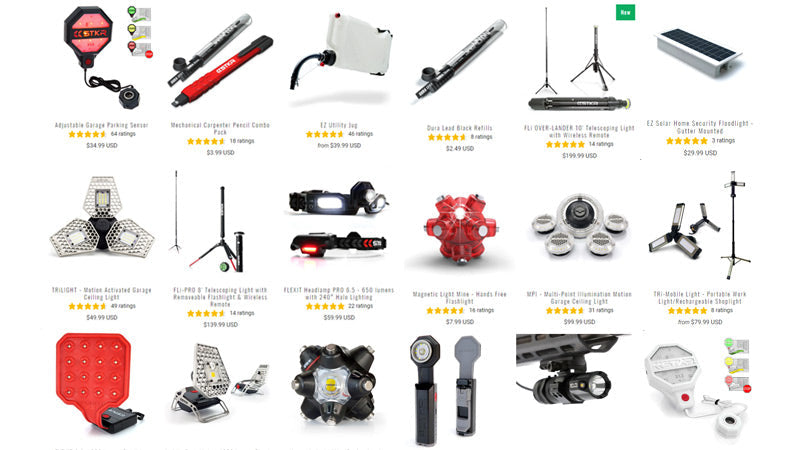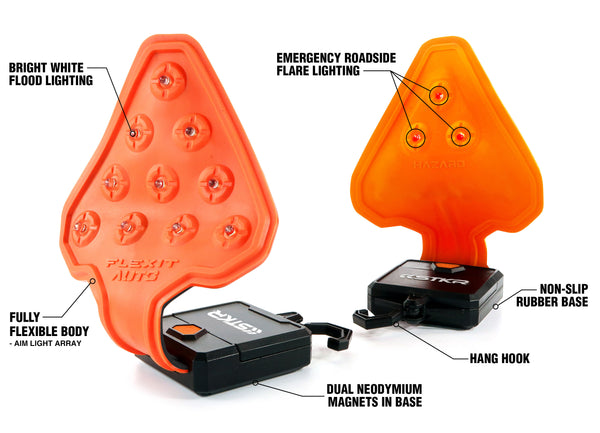
What are Warning Triangles?
Share
Sometimes things just happen while you are out on a drive. When they do, this means that you need to be as prepared as possible for not only your safety, but for other people on the road. Having a safety kit in your car for these unpredictable moments can be a wise investment to keep you safe. Among the items that you must include in your safety kit are warning triangles.
Warning triangles are devices that warn other drivers of a potential roadside hazard coming up. The primary goal of these warning triangles is to make sure that traffic knows that there is a stationary car coming up so that they can be safe driving around it. This will make sure that there are no car accidents, which can potentially be fatal if you don’t take the right precautions.
These are important to have because they:
- Improve visibility of your disabled vehicle.
- Warn traffic about your upcoming stationary vehicle.
By reading on, you can learn more about warning triangles and how to properly use them to get the most benefit from them. How you use them is just as important as having them.

How Do You Use Emergency Triangles?
If your car is stationary on the road, whether it’s disabled or you needed to pull over for any other reason than a traffic stop, you need to make sure that your car is visible to other drivers on the road. The first thing that you need to do is to make sure that you are pulled over to the far-right shoulder, ensuring that you’re not blocking traffic with your car. Your car should be as far off the driving area as possible for optimal safety.
Once your car has been pulled over to the side of the road, you need to then take the steps to make sure that your car is visible to the other drivers. You should be sure that you put your hazard lights on to help with this. It’s also a good idea to open your hood, if possible, in order to make sure that your car looks like a bigger object than it is so that people can see you.
After taking those steps for visibility, it’s then important to use emergency triangles to warn people of your stationary car. Whether you use small options like the STKR FLEXIT Auto Light or more traditional triangles, you should place these a proper distance away from each other and your car to ensure people know to expect your stationary vehicle.
Where are Emergency Triangles Placed?
The proper alignment of the emergency triangles is important in order to attract the attention of oncoming traffic. This can also alert people that you may need some help. So how do you set up the emergency triangles for optimal visibility? There are some standard rules that people use when placing these triangles, which is important to remember when you are using them. These are some important things to remember when using emergency triangles.

- The first emergency triangle should be about 10 feet behind your car. This should be directly behind the car, staying on the closest side to the flow of traffic.
- The second emergency triangle should be located about 100 feet behind the car. This should line up directly in the middle of the car’s current position.
- The third and last emergency triangle should be 300 feet away from your car. This should line up with your car on the side farthest from the road.
This specific alignment of emergency triangles is made to ensure that you get the attention of oncoming traffic so that you and the other drivers can be safe on the road. A lot of people die as a result of car accidents in these situations, which is why it’s so important for you to be very careful when dealing with these items.
How Much are Emergency Triangles?
The exact cost of emergency triangles will depend on the option that you get. Some warning triangles have high price tags because of their size or the materials that are used to create these products. For instance, an option with LED lights can be somewhere around $30 while those with reflectors can be around $20. Again, it all depends on the specific options that you are considering. LED-lit warning triangles can be the best investment because these will offer the highest level of visibility.
What Exactly is the Flexit Auto Warning Triangle and What Can It Do?
Here at STKR Concepts we design and create innovative lighting solutions that aren’t just copies of what someone else has done. We look at day-to-day lighting needs and we try to come up with something new that is a better solution to a common problem.
When you are stuck on the side of the road for whatever the reason may be, you want the rest of the traffic behind you to know about it and give you the safe distance you need to assess your vehicle’s situation. Most car issues are better diagnosed and/or repaired with the help of a flashlight. Well, here at STKR we thought why not have a flashlight that can also perform like a traffic warning triangle.
With the Flexit Auto, you get just that. A tool designed to warn oncoming traffic with its orange triangular body with built-in flashing red LEDs. On the reverse side, it has an array of white LEDs that put off 200 lumens of bright light to illuminate your vehicle or trailer giving you some much-needed light in the dark to try and rectify your situation.
How Far Should a Warning Triangle be From a Car?
There are some guidelines that you should know about when you are placing warning triangles away from your car. This section will take a look at these guidelines to ensure you stay safe:
- Anytime that you stop your car on the shoulder or in the travel lane, the law says that you need to have your hazard lights on.
- You need to put your warning triangles up as soon as possible after pulling over. Ideally, this should be done within the first 10 minutes of being pulled over.
- You want to be sure that the reflective material or the LED warning lights are facing traffic. This will ensure that people can see these warning triangles and know to be aware of your presence.
- If you’re on a straight road, you will want to follow the instructions previously mentioned as far as placement and distance from the car.
- If you’re on a curve, hill, or are located near some type of visual obstruction (within 500 feet of any of the above), there are special placements that you need to do. The warning triangle should be between 100 and 500 feet away from the disabled vehicle. This will give people plenty of warning about your stationary vehicle.
- If you’re stopped on a divided or one-way street, there should be a warning triangle at both 100 and 200 feet away from the car facing approaching traffic. There should be another one at about 10 feet from the rear of the car.
- If you’re stopped in a residential or business area, you’re not required to put down warning triangles, unless the lighting in the area is insufficient. It could still be a good idea to do at nighttime, but you don’t necessarily have to.
When Should You Use a Warning Triangle?
You should use your warning triangles whenever your car breaks down or is otherwise stationary on a road, as previously described in previous sections. You want to be sure that you are following the rules of the road by making sure that your warning triangles are placed as required by law. Anytime that you have a stationary car, it can be a good idea to use a warning triangle to make sure that you don’t cause an accident with your car.
The driver of the stationary car is legally required to make sure that they put the warning triangles down in the appropriate spots and within a reasonable amount of time. This will ensure the safety of yourself and everyone else on the road.
Conclusion
There are different types of warning triangles that you can get, ranging from large options or smaller, LED options. The smaller options may be the best option to consider, especially if you have a smaller car and don’t have room for the larger options. The good news is that with the STKR FLEXIT Auto Light, you get a hands-free and flexible option that is versatile. They have bright LED lights with 4 modes, offering you the visibility that you need to stay safe and warn other drivers about your stationary vehicle.
STKR now even has a roadside emergency lighting kit with a blaze orange safety vest. It is the best way to be seen at night and fix your issue.




